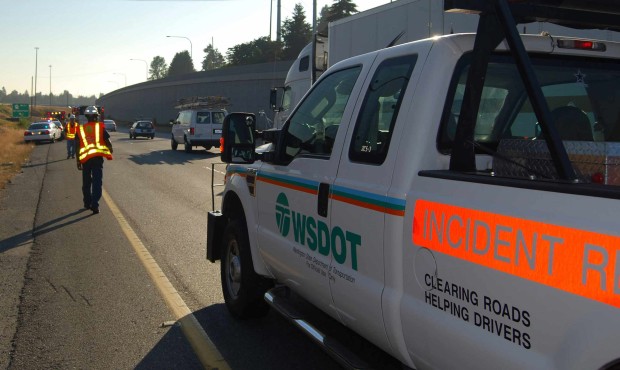Clearing the way: Effectiveness of state’s incident teams inspire Seattle
May 12, 2016, 6:02 AM | Updated: 1:23 pm

The City of Seattle is establishing traffic response teams similar to those seen along state roads. (WSDOT)
(WSDOT)
The state has cleared damaged cars out of the way for years with its Incident Response Teams. Now, the City of Seattle is trying to copy the state program with trucks of its own.
Drivers saw just how vital Incident Response Teams can be during the recent Alaskan Way Viaduct closure. There was one point in particular where a rolled car on I-5 was blocking an already packed roadway. The IRT truck just bulldozed it to the shoulder to get the lanes open as soon as possible.
Travis Phelps with the Washington State Department of Transportation says the IRT trucks clear 50,000 problems a year around the state. Most of those problems are cleared within 13 minutes, he says.
Related: Relief coming for drivers dealing with ‘SnoCo Squeeze’
“The only things we can’t clear is the big rollover semis. We need special equipment from our towing companies to do that,” Phelps explained. “We saw it during the viaduct closure. If someone is not hurt and we can get the vehicle out of the way we just push it out of the way. Our goal is to get the highway open as quickly as possibly.”
Law enforcement and other first responders have control in most situations on the roads. An IRT team typically has to wait until an investigation is over before it can clear a crash.
Phelps says the trucks are not pre-positioned in busy areas. Instead, they are assigned corridors and simply roam for their entire shifts.
“We usually have about four to five trucks on I-5 between Everett and Renton,” Phelps said. “We have one dedicated truck to for the 520 floating bridge as well as I-90 and we have two or three on the I-405 corridor at any given time. And those folks rove around constantly.”
There are up to 12 IRT trucks on the road at any given time, especially during the commutes. Some are assigned to highways such as 167, 18, 99 and 2. Drivers usually work 10-hour shifts, moving from problem to problem with the goal of opening lanes as fast as they can. And that’s just the region in King and Snohomish counties. There are IRT trucks working in most areas of the state.
WSDOT plans to add 10 more of these trucks, beginning in July, on the I-5 corridor. Six of those are coming to I-5 around Seattle.
“Traffic really is an issue no matter where you look on I-5, and a blocking stall or incident can make it that much worse. This will help keep things moving,” Phelps said.
The City of Seattle has rolled-out about five of these trucks in the last year as it tries to replicate the state model. The city was at work during the viaduct closure, focusing on moving things fast, which is a vast change over the previous mantra of protecting property over opening the roads.
The city trucks are currently called E-Laborer trucks, but they will soon be renamed Incident Management Team trucks or I-MTs. They will provide gas to cars, respond to signal outages, and even change tires. The city’s trucks will work regions, just like the state trucks.












